story and photos by Kayte Deioma
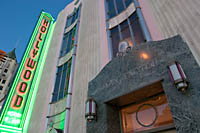 If you’re interested in Hollywood memorabilia, the Hollywood Museum is a great way to spend a few hours on a rainy day. Located in the old pink stucco and green marble Max Factor factory building, the Museum maintains some of the original displays from the Max Factor Museum as well as rotating exhibits from the Museum’s Hollywood History collection and some traveling exhibits related to Hollywood history.
If you’re interested in Hollywood memorabilia, the Hollywood Museum is a great way to spend a few hours on a rainy day. Located in the old pink stucco and green marble Max Factor factory building, the Museum maintains some of the original displays from the Max Factor Museum as well as rotating exhibits from the Museum’s Hollywood History collection and some traveling exhibits related to Hollywood history.
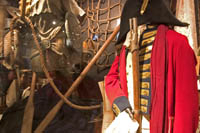 The Hollywood Museum has a wonderful collection of Hollywood costumes, props, set decorations and memorabilia. Although each exhibit has a theme, the individual pieces are rarely identified. Actor bios are placed around the exhibits – usually too close to the ground to be easily read – and sometimes reference which item displayed was worn or used by that actor. Despite the shortage of interpretive information, the collection is worth exploring.
The Hollywood Museum has a wonderful collection of Hollywood costumes, props, set decorations and memorabilia. Although each exhibit has a theme, the individual pieces are rarely identified. Actor bios are placed around the exhibits – usually too close to the ground to be easily read – and sometimes reference which item displayed was worn or used by that actor. Despite the shortage of interpretive information, the collection is worth exploring.
The first level showcases the four make-up rooms where Max Factor and his staff transformed actresses into movie stars. Separate rooms for redheads, blondes, brunettes, and brownettes (Max Factor’s own distinction for light to medium brown hair) are painted in colors to flatter the hair and skin tones.
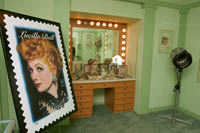 The “For Redheads Only” room is also sometimes referred to as the Lucy room. It is decorated with multiple portraits of Lucille Ball and features the makeup shades and hair color that turned the natural brunette into a redhead. The walls are painted green as a flattering backdrop for the redheads made-up here.
The “For Redheads Only” room is also sometimes referred to as the Lucy room. It is decorated with multiple portraits of Lucille Ball and features the makeup shades and hair color that turned the natural brunette into a redhead. The walls are painted green as a flattering backdrop for the redheads made-up here.
The room “For Blondes Only” is painted a cool blue. Legendary blondes like Mae West, Jean Harlow, June Allyson and Ginger Rogers had their make-up done here. Marilyn Monroe became a blonde here and even Lucille Ball was made up here during her short stint as a blonde. The walls are lined with Max Factor magazine ads featuring some the most famous faces to wear the Max Factor brand.
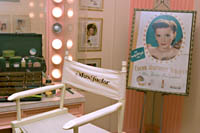 The peachy shades of the “For Brownettes Only” room were designed for the likes of Judy Garland, Lauren Bacall and Donna Reed. Elizabeth Taylor, Joan Crawford and Rosalind Russell are just a few of the many actresses featured in the “For Brunettes Only” room surrounded by flattering shades of pink. As a brunette, I have to admit I looked much better in the mirrors of the brunette room than the blonde room. Beyond the color themed rooms you walk past a glass-enclosed room where wigs were created and dyed, then through a hallway filled with Joe Ackerman’s Autograph Collection into a red room. The far wall is filled with original autographed photos of Hollywood stars that are rotated from the Museum’s extensive collection. On the near wall, historic photos of the Hollywood landscape arranged chronologically show how dramatically it has changed over the last hundred years.
The peachy shades of the “For Brownettes Only” room were designed for the likes of Judy Garland, Lauren Bacall and Donna Reed. Elizabeth Taylor, Joan Crawford and Rosalind Russell are just a few of the many actresses featured in the “For Brunettes Only” room surrounded by flattering shades of pink. As a brunette, I have to admit I looked much better in the mirrors of the brunette room than the blonde room. Beyond the color themed rooms you walk past a glass-enclosed room where wigs were created and dyed, then through a hallway filled with Joe Ackerman’s Autograph Collection into a red room. The far wall is filled with original autographed photos of Hollywood stars that are rotated from the Museum’s extensive collection. On the near wall, historic photos of the Hollywood landscape arranged chronologically show how dramatically it has changed over the last hundred years.
At the back of the Museum is a freight elevator that was used to carry cars up to a parking lot that used to be located on the top level of the building. The parking lot has been turned into a ballroom that is rented out for private functions, but the elevator, with a stained glass chandelier hanging from the highest level is still used to transport party guests to the upper floors for special events.
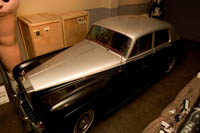 Cary Grant’s 1965 Rolls Royce Silver Cloud III is parked in the loading dock behind the elevator where you can look down on it from above. A couple giant “Bunny Legs” from the movie “Along Came Polly” tower in the center of the room with another one near the Rolls Royce. The film is playing on a monitor overhead. Movies are playing in various exhibits around the Museum. They are the movies in which some part of the exhibit was featured, but it is sometimes hard to tell which part of the exhibit is from the movie because there is no explanatory information.
Cary Grant’s 1965 Rolls Royce Silver Cloud III is parked in the loading dock behind the elevator where you can look down on it from above. A couple giant “Bunny Legs” from the movie “Along Came Polly” tower in the center of the room with another one near the Rolls Royce. The film is playing on a monitor overhead. Movies are playing in various exhibits around the Museum. They are the movies in which some part of the exhibit was featured, but it is sometimes hard to tell which part of the exhibit is from the movie because there is no explanatory information.
You have to go back to the front of the Museum to get to the stairs to go up to the next floor.
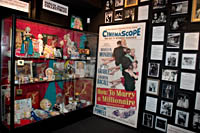 The second floor features a large Marilyn Monroe exhibit, one of the Museum’s most popular displays. It includes photos, costumes, movie posters, jewelry, memorabilia and of course Marilyn’s personal make-up case and its contents. One wall highlights Marilyn’s marriages and divorces in black and white photos. Another wall features an enlargement of Marilyn’s 1949 nude centerfold. Several of Marilyn’s films are running on different monitors.
The second floor features a large Marilyn Monroe exhibit, one of the Museum’s most popular displays. It includes photos, costumes, movie posters, jewelry, memorabilia and of course Marilyn’s personal make-up case and its contents. One wall highlights Marilyn’s marriages and divorces in black and white photos. Another wall features an enlargement of Marilyn’s 1949 nude centerfold. Several of Marilyn’s films are running on different monitors.
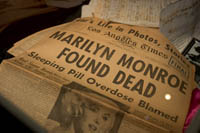 The exhibit is peppered with quotes from the star such as “It’s better to be unhappy alone than unhappy with someone else,” and “I want to grow old without face lifts. I want the courage to be loyal to the face that I have made.”
The exhibit is peppered with quotes from the star such as “It’s better to be unhappy alone than unhappy with someone else,” and “I want to grow old without face lifts. I want the courage to be loyal to the face that I have made.”
From a display case, the headline of a 1962 Los Angeles Times announces “Marilyn Monroe Found Dead.”
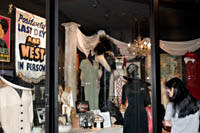 Next to Marilyn Monroe, Mae West has her own large display case with glamorous gowns, corsets and feather boas as well as awards, plaques, photos and other memorabilia. As with most of the exhibits in the Museum, very few items are individually identified.
Next to Marilyn Monroe, Mae West has her own large display case with glamorous gowns, corsets and feather boas as well as awards, plaques, photos and other memorabilia. As with most of the exhibits in the Museum, very few items are individually identified.
On my visit, The rest of the second floor featured a nice Greta Garbo exhibit and a collection of gowns from movies old and new worn by such Hollywood stars as Shirley Temple, Ingrid Bergman, Lana Turner, Bette Midler and Jodie Foster. There was also a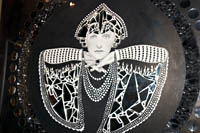 section devoted to Lucille Ball and Desi Arnaz including a three-reel film projector Desi invented for editing film from the three camera technique he developed.
section devoted to Lucille Ball and Desi Arnaz including a three-reel film projector Desi invented for editing film from the three camera technique he developed.
From December 1, 2005 at least until February 15, 2006, a special legacy exhibit on Barbra Streisand will occupy this space. Three thousand pieces of movie and music memorabilia related to the artist will be on display. This will be only the second exhibit at the museum to showcase a living artist. The first was a legacy exhibit on Phyllis Diller.
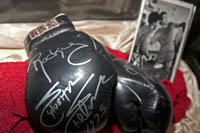 Third level exhibits include more recent Hollywood productions. Sylvester Stallone’s boxing gloves and robe from one of the Rocky movies is next to the door. There are a few costumes and set decorations from “Moulin Rouge” and many more from “Master and Commander.” One of Tom Cruises costumes from “The Minority Report” backs up to Tommy Lee Jones’ black suit and sunglasses from “Men in Black.” A collection of torture instruments from the movie “Quills” is
Third level exhibits include more recent Hollywood productions. Sylvester Stallone’s boxing gloves and robe from one of the Rocky movies is next to the door. There are a few costumes and set decorations from “Moulin Rouge” and many more from “Master and Commander.” One of Tom Cruises costumes from “The Minority Report” backs up to Tommy Lee Jones’ black suit and sunglasses from “Men in Black.” A collection of torture instruments from the movie “Quills” is 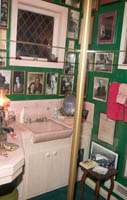 across from Roddy McDowell’s Powder Room transported from his home. A large exhibit on Hollywood’s honorary mayor, Johnny Grant and a nice Bob Hope tribute seem to be out of context on this floor.
across from Roddy McDowell’s Powder Room transported from his home. A large exhibit on Hollywood’s honorary mayor, Johnny Grant and a nice Bob Hope tribute seem to be out of context on this floor.
Hollywood history continues in the basement with Hanibal Lechter’s cell from Silence of the Lambs,” complete with the reduced-size folding chair that made Jodie Foster look especially small sitting outside his cell. The other prison cells on this block have been used in a number of films and are still rented out for filming prison scenes. At the end of the hall are more props from Red Dragon before you turn a corner and step into the Egypt in Hollywood exhibit. From the 1935 “Charlie Chan in Egypt,” to “Death on the Nile,” “Cleopatra” and “The Mummy’s Tomb,” posters, photos and movie props remind of Hollywood’s favorite Egyptian classics.
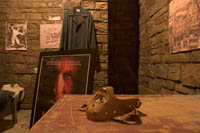 The Hollywood Museum is open Thursday through Sunday, 10 a.m. to 5 p.m. Adult admission is $15. Students up to 22 years of age are $12 and Children five and under are $5. The Museum is located at 1660 N. Highland Ave., just south of Hollywood Blvd. There is a $2 parking discount at the adjacent parking lot with Museum validation. Parking across Hollywood Blvd. at the Hollywood & Highland shopping complex is $2 for 4 hours with validation from any of the Hollywood & Highland businesses. Check out their web site,www.thehollywoodmuseum.com, for current exhibits and special offers. Discount coupons are also sometimes distributed across the street in front of Grauman’s Chinese Theatre.
The Hollywood Museum is open Thursday through Sunday, 10 a.m. to 5 p.m. Adult admission is $15. Students up to 22 years of age are $12 and Children five and under are $5. The Museum is located at 1660 N. Highland Ave., just south of Hollywood Blvd. There is a $2 parking discount at the adjacent parking lot with Museum validation. Parking across Hollywood Blvd. at the Hollywood & Highland shopping complex is $2 for 4 hours with validation from any of the Hollywood & Highland businesses. Check out their web site,www.thehollywoodmuseum.com, for current exhibits and special offers. Discount coupons are also sometimes distributed across the street in front of Grauman’s Chinese Theatre.
The Hollywood Museum in the Historic Max Factor Building is included in the Go Los Angeles Card attraction pass.
Find and book Los Angeles tours and activities on Viator.com. Book ahead to save time and money!
Check Goldstar.com for discount tickets to LA shows, events and attractions.
